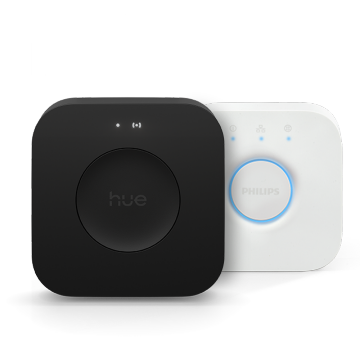Smart lighting is a more advanced way to light your home.
What is smart lighting?
In this article...

How do smart lights work?
Smart lights have a chip inside them so they can communicate with other devices wirelessly. Every light can connect to an app, smart home assistant or other smart accessory, so you can automate your lights, change their colour or control them remotely.
So, how are they different from regular lights? Conventional lights can only turn on or off. You can dim them, but only with a wired switch.
Smart lighting technology
There are multiple technologies that can make a light smart. Zigbee, Bluetooth and Wi-Fi are the most popular.
Zigbee lights
Zigbee is a type of wireless communication protocol that allows smart devices to "talk" to each other. It's common in smart home technology because it's very secure, low power (your smart switches won't drain their batteries!) and works even when the Wi-Fi is down.
Wi-Fi lights
Wi-Fi is a popular technology for smart lighting because it's familiar. Your lights use your home's Wi-Fi network to communicate with each other. There are downsides to using this tech, though: your Wi-Fi may be overloaded, the lights don’t work when the router is down and the range is limited to your Wi-Fi signal.
Bluetooth lights
Bluetooth is a wireless communication technology that uses RF signals to send data. It’s easy, requires no other hardware and is accessible by almost everyone. But Bluetooth only stores limited data per device, and it’s only usable within short distances.
*Zigbee and Wi-Fi use the same frequency band (2.4 GHz), but Zigbee does not use any Wi-Fi bandwidth to control the lights.
**Lights can be controlled via smart switches and automations, but app and away-from-home control are excluded.

What is a smart hub?
Zigbee smart lights become really smart when they connect to a smart hub that creates a super-fast Zigbee network between them and connects them to the Internet.
Once the signal is established, the lights build a mesh network. This is why you can add lights everywhere in your home, and they all 'just work' – because each light is a repeater that extends and strengthens the Zigbee network.
In the Philips Hue system, there are two hubs: the Bridge and Bridge Pro.

LED technology
Why are smart lights LED? A few reasons:
1. They don't heat up like other types of lights, which would damage the chip that makes them smart.
2. LEDs already have internal electronics, so it's easy to include the smart chip.
3. They can produce millions of light colors.
4. They're the current standard in home lighting, due in part to LED energy efficiency.
So, that's one acronym out of the way. There are a few others, like RGB, IC, WW... these acronyms refer to the colors of the LEDs.
Did you know? Signify, the company behind Philips Hue, is also behind Color Kinetics, which focuses on 'dynamic architectural lighting systems' (this means fancy professional lighting for arenas and light shows, etc). One of their biggest research areas is colour — that means we've got access to the best of the best in colour lighting.
RGB lights
Stands for “red, green, blue”.
RGB lights mix red, green and blue LEDs (the primary colours of light) to create a wide variety of colours – over 16 million, to be a little more precise. RGB lights do not have white LEDs, but they can still produce a shade of white by mixing red, green and blue. These lights can only produce one solid colour at a time.
RGBIC lights
Stands for “red, green, blue” and “independent controller”.
You might also see "independent control" or "independent chip," but they all mean the same thing: you can control the different LEDs individually, so it displays multiple colors at the same time.
RGBA lights
Stands for “red, green, blue, amber”.
RGBA lights use amber in addition to red, green, and blue so that they can display a wider range of yellow light, including orange and gold.
RGBW lights
Stands for “red, green, blue, warm white”.
RGBW lights (also sometimes called RGBWW lights, confusingly enough) also feature a warm white chip to include thousands of additional shades of white light. This is how you get a range of warm-to-cool white light.
RGBWW lights
Stands for "red, green, blue, cool white, warm white”.
The two different white LEDs mean that the light can produce even richer colors. Most Philips Hue colour lights feature this technology.
RGBWWIC lights
Stands for “red, green, blue, cool white, warm white” and “independent controller”.
This is the technology that most Philips Hue gradient lights have. You get all the colours of light you want, and you can set multiple colours at the same time. With our gradient lights, you control groups of LEDs rather than single LEDs at a time – this helps create seamless blends of colour.
Why would you need smart lighting?
The benefits of smart lighting don't stop at controlling your lights remotely.

Convenience
Lights that do what you want, when you want. Walk past, and the lights turn on. Bedtime? The lights dim automatically. Hands full? Tell your smart home assistant what to do. Smart lighting isn't just smart — it makes life a little bit easier.

Voice control
One of the most sought-after features of smart lighting, voice control lets you adjust your lights with a command. "Alexa, turn on the lights." "Siri, make the living room cosy."

Automations
Schedule your lights to go on and off at certain times – and with certain settings. Plus, special automations – like Wake up and Go to sleep – give you even more advanced functionality.

Easy dimmable light
Traditional bulbs need a special dimmer switch that's wired into your home’s electricity. With smart lights, dimming is built in – the app, smart switches and even your voice can dim your lights instantly.

Surround lighting
Sync your lights to your TV or computer and watch as they dance, flash, dim, brighten, and change color along with its content on the screen.

Get cool light effects
Make your lights sparkle, mimic a fireplace or twinkle like the stars. You can even let your lights cycle through colours.

Connect with other devices
With communication protocols, like Matter, creating an entire smart home is simple. Use your smart lighting system with other connected devices, such as cameras, speakers, thermostats and home assistants.








